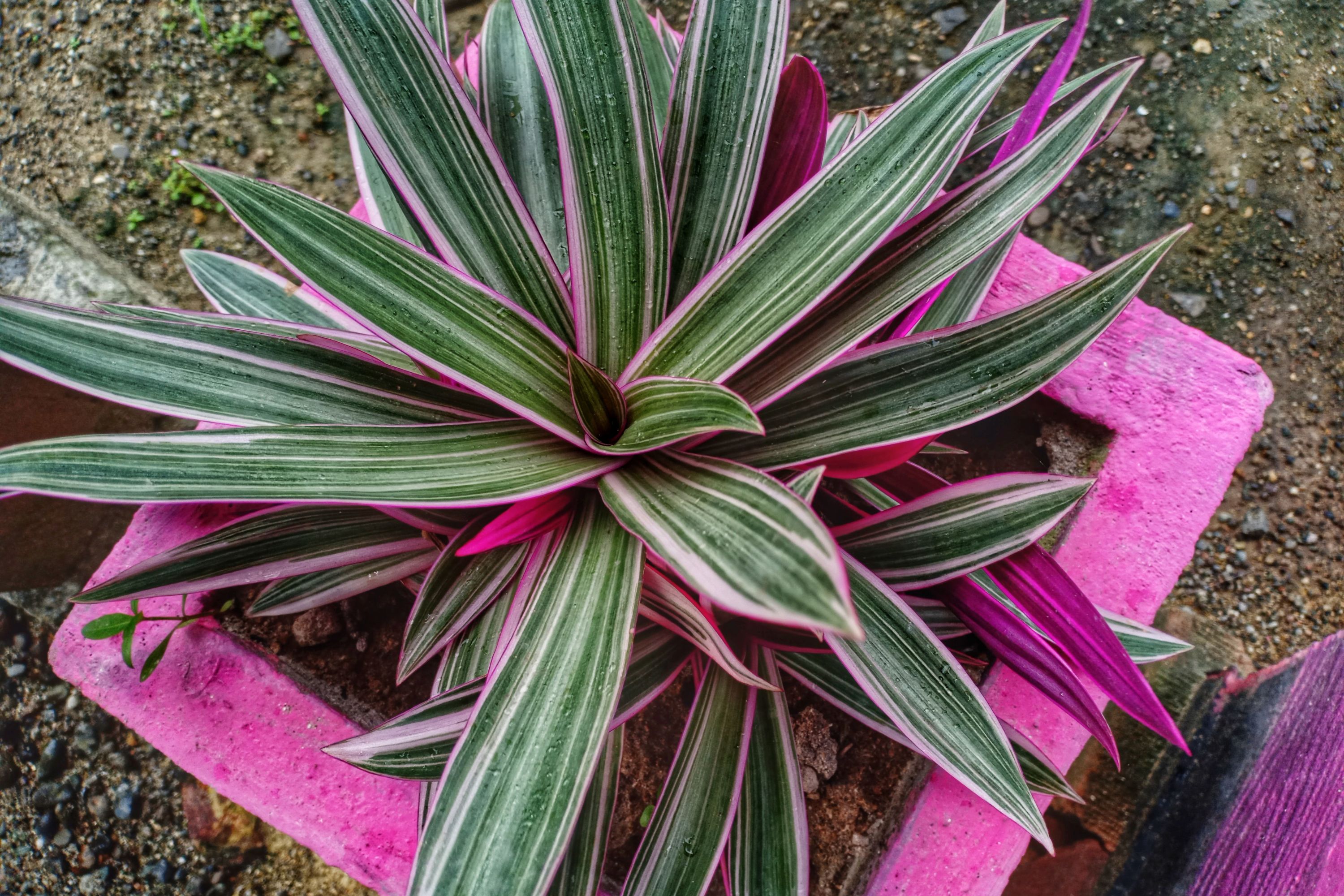Moses-in-the-cradle
(Tradescantia spathacea)

Description
Tradescantia spathacea, commonly known as the Moses-in-the-Cradle or oyster plant, is a member of the spiderwort family (Commelinaceae). It is native to Mexico, Belize, and Guatemala, but is now cultivated worldwide as a houseplant or as an ornamental plant in gardens. This plant is highly valued for its attractive foliage, which is an eye-catching combination of purple and green colors. In this article, we will delve deeper into the various aspects of Tradescantia spathacea, from its physical appearance to its care requirements. Physical Characteristics: The Moses-in-the-Cradle is a small herbaceous perennial that can reach a height of up to 30 cm (12 inches) and a spread of up to 60 cm (24 inches). Its leaves are lance-shaped, pointed, and grow in a rosette pattern. The leaves can grow up to 15 cm (6 inches) long and are green on the upper surface and purple on the underside. The plant produces a spike of small white flowers, but they are not very showy and are often removed to encourage vegetative growth. The flowers are followed by small capsules containing black seeds. Varieties: There are several cultivars of Tradescantia spathacea that are cultivated for their ornamental value. The most popular cultivar is the 'Vittata' variety, which has green leaves with yellow stripes along the edges. The 'Tricolor' variety has green leaves with cream-colored margins and pink stripes. The 'Sitara' variety has green leaves with pink and purple variegation. Another cultivar, 'Quadricolor,' has leaves with green, white, pink, and purple colors. Propagation: The Moses-in-the-Cradle can be easily propagated from stem cuttings. Cut a stem with several leaves, remove the lower leaves, and place the cutting in a pot with moist soil. Keep the cutting in a warm, humid location with bright, indirect light until roots develop, and new growth appears. Propagation can also be done by division when the plant has outgrown its container. Light Requirements: Tradescantia spathacea prefers bright, indirect light. Direct sunlight can burn the leaves, especially those with variegation. If the plant is grown in low light, it may become leggy and lose its colorful foliage. If grown outdoors, it should be placed in a partially shaded location. Watering: The Moses-in-the-Cradle prefers moist but well-draining soil. Water the plant thoroughly when the top inch of soil feels dry to the touch. Do not allow the plant to sit in water, as this can lead to root rot. In winter, reduce watering frequency as the plant goes into dormancy. Temperature and Humidity: Tradescantia spathacea prefers warm temperatures between 18°C to 27°C (65°F to 80°F). It can tolerate temperatures as low as 10°C (50°F) but may suffer damage if exposed to frost. The plant prefers moderate to high humidity levels and can benefit from occasional misting. Fertilizer: The Moses-in-the-Cradle can be fertilized with a balanced fertilizer every 2-4 weeks during the growing season. Reduce fertilization frequency in winter when the plant is dormant. Do not over-fertilize, as this can lead to burning of the roots. Pests and Diseases: Tradescantia spathacea is generally a low-maintenance plant that is not highly susceptible to pests and diseases. However, like all plants, it can be affected by a few common issues. Here are some of the pests and diseases that can affect Tradescantia spathacea: Mealybugs: These small, white, cotton-like insects can infest the foliage and stems of Tradescantia spathacea, sucking out the sap and causing yellowing, wilting, and stunted growth. They can be controlled with insecticidal soap or neem oil. Spider mites: These tiny, spider-like pests can infest the undersides of leaves and spin webs, causing leaf discoloration, webbing, and leaf drop. They can be controlled with insecticidal soap or neem oil. Scale insects: These small, brown, oval-shaped pests can attach themselves to the leaves and stems of Tradescantia spathacea, sucking out the sap and causing yellowing, wilting, and stunted growth. They can be controlled with insecticidal soap or neem oil. Root rot: Overwatering can cause the roots of Tradescantia spathacea to rot, leading to wilting, yellowing, and stunted growth. To prevent root rot, ensure that the plant is grown in well-draining soil and water only when the top inch of soil feels dry to the touch. Fungal diseases: Tradescantia spathacea can be susceptible to fungal diseases such as leaf spot and powdery mildew. These diseases can cause leaf discoloration, wilting, and leaf drop. To prevent fungal diseases, ensure that the plant is grown in well-ventilated conditions, avoid overhead watering, and remove any infected leaves promptly. In general, it is important to maintain good plant hygiene and avoid overwatering to prevent the development of pests and diseases in Tradescantia spathacea. If you notice any signs of infestation or disease, it is important to take prompt action to prevent further damage to the plant.
Taxonomic tree:







